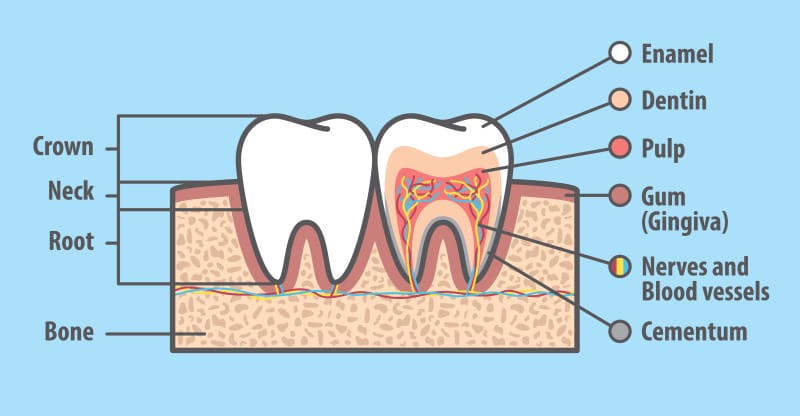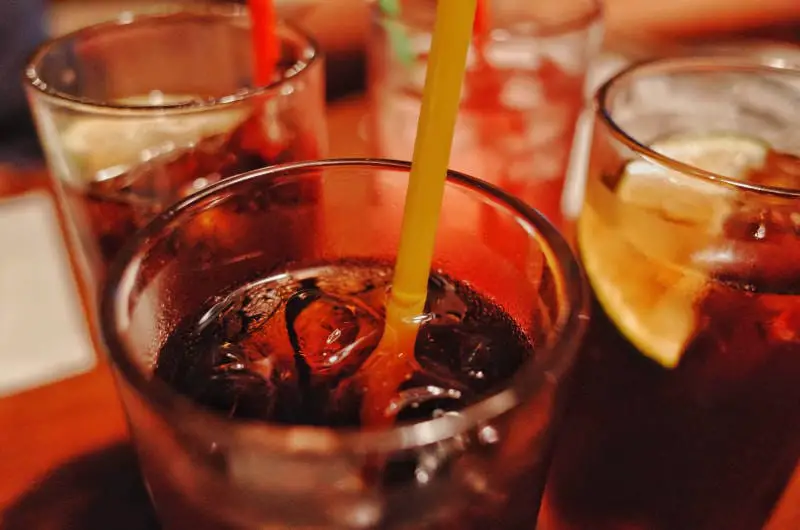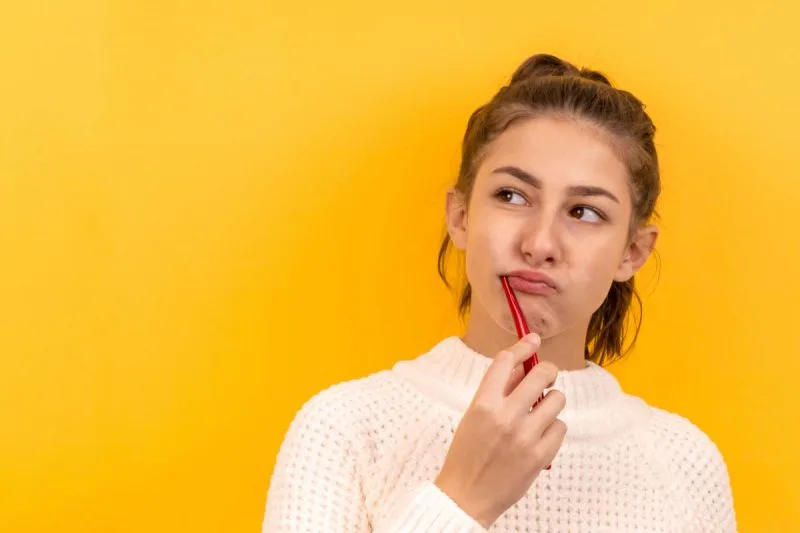Worried that your teeth are starting to yellow, even when you are doing your best to brush them properly? You aren’t alone. Even when following the best advice, teeth can become stained.
However, most of the time it happens because of incorrect brushing advice given when we were younger. We’ve got a few tips for you, as well as some easy hacks that could potentially help your teeth look brighter and healthier.
Why Are My Teeth Yellow When I Brush Them Everyday?
Teeth can yellow for a number of reasons, even if you are brushing them properly every day. Normally, yellow teeth are a result of worn enamel caused by poor diet, smoking, certain drinks, aging, and genetics.
But there could be a few things you’ve been doing wrong for a while without knowing. Many of us grew up with some teeth health myths that could do with being broken. First though, let’s find out why teeth turn yellow.
Why Do Teeth Turn Yellow?
Teeth become more yellowish in color in a few ways. The main reason is that the outer enamel of the tooth wears down or weakens. Enamel isn’t pure white, it’s actually semi-translucent. That means a thick enamel layer looks white as it doesn’t show much of what’s behind it, but a thinner layer exposes more of what sits behind it.
Dentin is one of the inner parts of a tooth and is a yellowish color. As enamel is weakened or worn down, more of the yellow dentin shows through. There are a lot of reasons for this that we’ll cover below. Luckily, some of them can be easy to fix!

1 – Not Brushing & Flossing Properly
You could have yellow teeth even when you brush every day purely because of poor technique!
Brushing isn’t as simple as a bit of back and forth with some toothpaste and you’re done. If you don’t brush the front and back of each tooth, brush too hard, don’t use a softer brush (harder isn’t better), and don’t do it two or three times a day you could actually be missing out on brushing properly.
You should also make sure your toothbrush is clean and sterilized. Boiling your toothbrush is an easy way to clean it every few months, but consider replacing the brush once every three to four months instead.
How To Brush Your Teeth Properly
This is a complete guide to brushing properly with a manual toothbrush. With an electric toothbrush, it’s very similar. The main difference is that with an electric toothbrush you don’t have to do the moving motion yourself.
- Use a soft to medium brush. Harder bristles are not better, they are worse!
- Use around a pea-sized amount of toothpaste that contains fluoride
- Brush each tooth individually – be gentle
- Use a circular motion, not a back and forth
- Brush at a 45-degree angle – i.e. point towards the gums, not back and forth across the teeth
- Brush the front, bottom, and back of your teeth. Don’t be tempted to skip what you can’t see from the front
- When brushing, imagine flicking the plaque and debris away from your teeth
- When brushing the back of the front teeth (upper and lower) you can point the toothbrush straight up or down and try to imagine pulling that debris out and away
- Brush for two minutes, trying to divide the time evenly
- Scrub your tongue to remove debris but don’t go too far back
- Spit out the toothpaste and wipe your mouth clean but don’t spit out the toothpaste! Keeping fluoride in the mouth protects your enamel
- Floss at least once a day, using either standard dental floss, interdental brushes, or a water flosser.
- Change your toothbrush once every three months
2 – Smoking
Smoking is a huge cause of yellowed and stained teeth. Quitting is also one of the simplest changes you can make to reduce teeth yellowing. That being said, not everything that is simple is easy. There are a few reasons why smoking causes yellow teeth: –
- The nicotine and tar in cigarettes, chewing tobacco, and other tobacco products is yellow, and it leaves stains on the teeth
- Smoking also causes dry mouth. Saliva protects your teeth, so less saliva overall leads to more enamel erosion
- Smokers are more prone to gum disease, which often leads to dental problems like gum recession. This in turn leads to yellowing of the teeth
Luckily, once you stop smoking there are a few routes to getting those teeth white again. Using a whitening toothpaste, visiting a dental hygienist for a cleaning, then getting your teeth whitened with a specialist can all reverse yellowing fairly quickly after smoking.
3 – Soda, Coffee, Tea & Red Wine

Acidic drinks and certain drinks that are heavily colored can cause staining of your teeth as well as weakened enamel. All soda and fizzy drinks use carbonic acid for the carbonation that gives them their fizz. When submerged in acid liquids, tooth enamel dissolves – so limit your intake.
Tea, coffee, and red wine all contain tannins – which can stain teeth. Some soft drinks like Coke and Pepsi contain both tannins and are highly acidic. Though these are the usual suspects, things like fruit juice also contain high levels of acid, with darker juices like cranberry and grape juice also having tannins.
While in a perfect world you’d never touch a sip of these again, it’s not too bad if you indulge occasionally. However, think about limiting yourself if you are concerned about having whiter teeth. You can also rinse your mouth out with water shortly after drinking these to avoid the bad stuff hanging around too long.
4 – Poor Diet
As well as the drinks above, a poor diet that is high in sugar is a big cause of yellow teeth. Sugar and teeth just do not mix. When sugar sits in your mouth while eating candy, cake, and other sweet treats, the bacteria in your mouth produce acid to break it down.
This acid is also highly effective at breaking down tooth enamel. On top of this, enamel breakdown can lead to cavities. This is very common in children and leads to fillings. Cavities are small holes in the enamel, which contribute to the breakdown of the enamel overall.
So eating sugar breaks down enamel, leaving dentin to show through – meaning teeth look yellow. Sugary drinks like orange juice and soda are common problems, so check our full article on food to avoid with braces for a breakdown.
5 – Over Brushing
Brushing too hard, for too long, using a hard bristle brush, or brushing incorrectly can all be bad for your teeth. Hard brushes and brushing too firmly literally wears down enamel, exposing the yellow dentin. Switch to a soft brush and brush lightly.
The bristles shouldn’t be completely splayed out, just pushed down a bit. Dentists recommend replacing your toothbrush or electric toothbrush head once every three months.
Consider switching to an electric toothbrush. They had a pressure sensor that tells you when you are brushing too hard. They also have a built-in timer that tells you when to switch to different parts of your mouth and when to stop. This one does the job perfectly.
6 – Damage
When a tooth is damaged from a crack (often from a knock in sports), or from habitual grinding, the outer layer of enamel can be worn down and expose the inner dentin. This can lead to teeth appearing yellow. Seeing a dentist after cracking or knocking a tooth can help avoid later problems.
Sometimes when a tooth is knocked it will start to turn gray. This indicates the root of the tooth is dying or dead. The color shows through the outer enamel layer. A root canal is often needed here to save the tooth, and bleaching can then restore the color.
6 – Genetics
Some of us are just born with weaker enamel. This means the enamel wears down faster and our teeth will look yellower than others. You could always try a tooth whitening treatment with a dental professional but bear in mind your teeth may also be a little more sensitive than others.
People with certain health conditions like cleidocranial dysplasia (like Dustin from Stranger Things – aka Gaten Matarazzo) will also have weaker enamel than most.
7 – Antibiotic Use
Some antibiotics can cause tooth discoloration. Tetracycline as well as its derivatives minocycline and doxycycline can lead to darkening of the internal part of the tooth. This is most common when children are given the antibiotic, so it’s not common for these to be prescribed at a young age or for certain people.
If you think that antibiotic use could have caused your teeth to become stained or darker, speak to a dental professional about what you could do to help this.
Can Yellow Teeth Go Away With Brushing?
Yes, when you have yellowed teeth from brushing improperly or not enough, brushing will help. Use our tips above (soft bristles, wait 30 mins after food/drink, fluoride toothpaste, brush evenly and softly) and use a whitening toothpaste (not a charcoal one!) then you can remove some staining.
Whitening toothpastes that contain fluoride, hydrogen peroxide, and baking soda do have a whitening effect on teeth according to a large-scale scientific review.

Why Are My Teeth Yellow With Braces?
If you feel that your teeth are yellower since you’ve had braces put on, it could be one few things. Getting braces makes it much harder to clean your teeth properly. Acid, bits of food, and plaque can all accumulate easier around the metal and rubber parts of the braces.
This means you have to really brush properly as well as floss regularly. We’d suggest using interdental brushes of different sizes, as using floss isn’t as effective with braces.
Get a larger and smaller set of interdental brushes. The larger is for in between the braces and your teeth, for the awkward spots your brush can’t quite reach. The smaller ones are for the gaps in your teeth you’d normally use floss on.
A water flosser can also be helpful to remove bits of food that are annoying to get at. However, we’d suggest it as an additional tool for quick cleaning when you don’t have time for a full floss.
It could also be that you are spending a lot more time looking at your teeth and they haven’t changed color. Certain colors of rubber bands used also make your teeth look yellower or whiter. You might find that the different shades of blue rubber bands look better and make your teeth look whiter.
It could also be the glue that holds the braces brackets to your teeth. Once you’ve had your braces removed, this leftover glue will be buffed off. As long as you’ve looked after your teeth properly you’ll find the color will go back to normal
How To Get Rid Of Yellow Teeth After Braces?
If you have yellow teeth after braces, give yourself a week or two of fully cleaning and flossing while using whitening toothpaste. You might find that any excess plaque has then been removed. After this, we’d suggest contacting a dental professional about tooth whitening.
You can do this at the dentist’s office or at home. Commonly you’ll do the first in the office and later ones at home with a gel. If you got a plastic retainer after finishing your braces treatment you’ll probably use this as the tray for the whitening.
